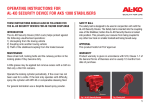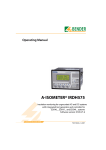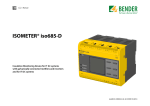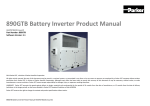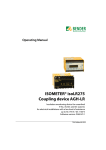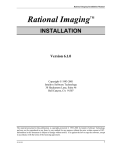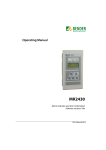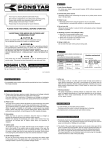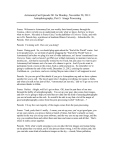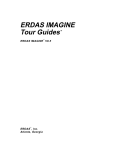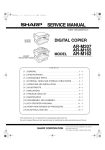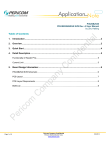Download A-ISOMETER® IRDH275 IRDH275B
Transcript
Operating Manual A-ISOMETER® IRDH275 IRDH275B Insulation monitoring device for IT AC systems with galvanically connected rectifiers and converters and for IT DC systems Software version IRDH275: D160 V1.8 Software version IRDH275B: D159 V1.8 Power in electrical safety TGH1361en/05.2011 Bender Inc. USA: 700 Fox Chase Coatesville, PA 19320 Toll Free: 800-356-4266 Phone: 610-383-9200 Fax: 610-383-7100 E-mail: [email protected] Canada: 5810 Ambler Drive, Unit 1 Mississauga, ON L4W 4J5 Toll Free: 800-243-2438 Phone: 905-602-9990 Fax: 905-602-9960 E-mail: [email protected] © Bender Inc. Web: http://www.bender.org All rights reserved. Content subject to change. Table of Contents 1. Safety information .................................................................................. 7 1.1 Use for the intended purpose ............................................................................. 7 1.2 Warranty and liability ............................................................................................. 7 1.2.1 1.2.2 1.2.3 1.2.4 1.2.5 Personnel .................................................................................................................... About the operating manual .............................................................................. Hazards when handling the A-ISOMETER® IRDH275 .................................. Inspection, transport and storage ..................................................................... Note .............................................................................................................................. 8 8 8 9 9 1.3 Explanations of symbols and warnings ........................................................... 9 1.4 Directions for installation ................................................................................... 10 2. Function ................................................................................................. 11 2.1 Common characteristics (IRDH275 and IRDH275B) .................................. 11 2.2 Additional characteristics IRDH275B .............................................................. 11 2.3 Product description .............................................................................................. 12 2.4 Function .................................................................................................................... 12 2.5 Additional functions IRDH275B ........................................................................ 15 3. Commissioning flow chart (threepart) ............................................. 19 4. Connection ............................................................................................ 23 4.1 Wiring ......................................................................................................................... 23 4.2 Wiring diagrams with coupling devices ........................................................ 26 4.2.1 Connection with AGH150W-4 ........................................................................... 26 4.2.2 Connection with AGH520S ................................................................................ 27 4.2.3 Connection with AGH204S-4 ............................................................................ 28 5. Operation and setting ......................................................................... 31 5.1 Operating features and displays IRDH275(B) .............................................. 31 5.1.1 Display in the standard mode ........................................................................... 32 TGH1361en/05.2011 3 Table of Contents 5.1.2 Display in the menu mode ................................................................................. 32 5.1.3 Function keys .......................................................................................................... 33 5.2 Menu structure and menu mode ................................................................. 35 5.2.1 Diagram menu structure ..................................................................................... 36 5.3 Menu HISTORY INFO (IRDH275B) ................................................................ 37 5.3.1 Diagram HISTORY INFO (IRDH275B) ............................................................... 38 5.4 Menu ISO SETUP: Setting of the basic A-ISOMETER® functions ............................................... 39 5.4.1 5.4.2 5.4.3 5.4.4 Response values Alarm 1 and Alarm 2 ........................................................... 39 Operating principle of the alarm relays ......................................................... 39 Memory setting (on/off) ...................................................................................... 41 Current output for external measuring instruments (IRDH275B) ............................................................................................................... 41 5.5 Menu ISO ADVANCED: Setting of the extended functions .................................................................. 42 5.5.1 External coupling devices (AGH: no) .............................................................. 42 5.5.2 Adaptation to the system leakage capacitance (Cemax: 150 μF) ...................................................................................................... 43 5.5.3 Changing the measuring principle from AMP to DC (Measure: AMP) ....................................................................................................... 43 5.5.4 Setting the repetition time for automatic self tests (Autotest: 24h) ........................................................................................................ 43 5.5.5 Setting the real-time clock (Clock) (IRDH275B) .......................................... 43 5.5.6 Setting the date (Date) (IRDH275B) ................................................................ 43 5.5.7 Specifying the starting time of the automatic self test (Test) (IRDH275B) ................................................................................................... 43 5.5.8 Diagram ISO ADVANCED .................................................................................... 44 5.6 Menu COM SETUP: Setting the BMS interface ................................................................................... 45 5.6.1 5.6.2 5.6.3 5.6.4 Bus address „Addr:“ (IRDH275B) ...................................................................... 45 ISOnet function (IRDH275B) .............................................................................. 45 ISO monitor (IRDH275B) ...................................................................................... 45 Diagram COM SETUP (IRDH275B) .................................................................... 46 5.7 Menu PASSWORD ............................................................................................... 47 5.7.1 Activating and setting the password ............................................................. 47 5.7.2 Diagram PASSWORD ............................................................................................ 47 4 TGH1361en/05.2011 Table of Contents 5.8 Menu LANGUAGE .................................................................................................. 48 5.8.1 Setting the national language .......................................................................... 48 5.8.2 Diagram Language ............................................................................................... 48 5.9 Menu SERVICE ......................................................................................................... 49 5.10 Parameterization via Internet ........................................................................... 49 6. Serial interfaces ..................................................................................... 51 6.1 RS485 interface with IsoData protocol (IRDH275) ..................................... 51 6.2 RS485 interface with BMS protocol (IRDH275B) ......................................... 53 6.3 Topology RS485 network (IRDH275B) ............................................................ 54 6.3.1 Correct arrangement ............................................................................................ 54 6.3.2 Wrong arrangement ............................................................................................. 54 6.3.3 Wiring ......................................................................................................................... 54 6.4 BMS protocol (IRDH275B) ................................................................................... 55 6.4.1 BMS Master .............................................................................................................. 55 6.4.2 BMS Slave ................................................................................................................. 56 6.4.3 Commissioning of an RS485 network with BMS protocol ...................... 57 7. Technical data IRDH275(B) .................................................................. 59 7.1 Data in tabular form ............................................................................................. 59 7.2 Standards, approvals and certifications ........................................................ 62 7.3 Characteristic curves ............................................................................................ 63 7.4 Ordering details ..................................................................................................... 70 7.4.1 7.4.2 7.4.3 7.4.4 A-ISOMETER® ........................................................................................................... 70 Coupling devices ................................................................................................... 71 Measuring instruments ....................................................................................... 71 Label for modified versions ............................................................................... 71 INDEX ............................................................................................................ 73 5 TGH1361en/05.2011 1. Safety information 1.1 Use for the intended purpose The A-ISOMETER® is intended for: z monitoring the insulation resistance of IT systems Any other use, or any use which goes beyond the foregoing, is deemed to be use other than for the intended purpose. The Bender companies shall not be liable for any losses or damage arising therefrom. Use for the intended purpose also includes z compliance with all information in the operating instructions, and z compliance with test intervals. As a basic principle, our "General conditions of Sale and Delivery" shall apply. At the latest, these shall be available to the operator when the contract is concluded. 1.2 Warranty and liability Warranty and liability claims in cases of damage to persons and property shall be excluded if they are attributable to one or more of the following causes: z Use of the A-ISOMETER® other than for the intended purpose z Incorrect assembly or installation, commissioning, operation and maintenance of the A-ISOMETER®. z Failure to comply with the information in the operating instructions regarding transport, commissioning, operation and maintenance of the A-ISOMETER®. z Unauthorized structural modifications to the A-ISOMETER®. z Failure to comply with the technical data z Improperly executed repairs, and the use spare parts or accessories which are not recommended by the manufacturer. z Cases of disaster and force majeure z Assembly and installation with device combinations not recommended. This operating manual, especially the safety information, must be observed above all by personnel who work on the A-ISOMETER®. In addition, the rules and regulations that apply for accident prevention at the place of use must be observed. TGH1361en/05.2011 7 Safety information 1.2.1 Personnel Only appropriately qualified staff may work on the A-ISOMETER®. Qualified means familiar with the installation, commissioning and operation of the product and with training appropriate to the work. Personnel must have read and understood the safety section and warning information in this operating manual. 1.2.2 About the operating manual This operating manual has been compiled with the greatest possible care. Nevertheless, errors and mistakes cannot be entirely ruled out. The Bender companies assume no liability whatsoever for any injury to persons or damage to property which may be sustained as a result of faults or errors in this operating manual. 1.2.3 Hazards when handling the A-ISOMETER® IRDH275 The A-ISOMETER® IRDH275 is constructed according to the state-of-the-art and recognized technical safety rules. Nevertheless, when it is being used, hazards may occur to the life and limb of the user or third parties, or there may be adverse effects on the A-ISOMETER® or on other valuable property. The A-ISOMETER® must only be used: z for the purpose for which it is intended z when it is in perfect technical condition as far as safety is concerned Any faults which may impair safety must be eliminated immediately. Impermissible modifications and the use of spare parts and additional devices which are not sold or recommended by the manufacturer of the devices may cause fires, electric shocks and injuries. Unauthorized persons must not have access to or contact with the A-ISOMETER®. Warning signs must always be easily legible. Damaged or illegible signs must be replaced immediately. 8 TGH1361en/05.2011 Safety information 1.2.4 Inspection, transport and storage Inspect the dispatch packaging and equipment packaging for damage, and compare the contents of the package with the delivery documents. In the event of damage in transit, please inform the Bender company immediately. The devices must only be stored in areas protected from dust, damp and spray or dripping water, and in which the specified storage temperatures are maintained. 1.2.5 Note Make sure that the operating voltage is correct! Prior to insulation and voltage tests, the A-ISOMETER® must be disconnected from the power system for the duration of these tests. In order to check the proper connection of the device, it is recommended to carry out a functional test. Make sure that the basic settings meet the requirements of the system. Children and unauthorized persons must not have access to or contact with the AISOMETER®. 1.3 Explanations of symbols and warnings The following symbols are used in Bender documentation to draw attention to important information and to make it easier to find certain text passages. The following examples explain the meaning of the symbols: The "Attention" symbol is used to draw attention to information warning employees of hazardous situations. Information you should know for correct handling of the product is marked with the "Info" symbol. TGH1361en/05.2011 9 Safety information 1.4 Directions for installation Only one insulation monitoring device may be used in each interconnected IT system. When insulation or voltage test are to be carried out, the device shall be isolated from the system for the test period. The terminals and KE shall be connected by a separate wire to the protective conductor (PE). If the terminals L1, L2 of the device are connected to a system under operation, the terminals and KE must not be disconnected from the protective conductor (PE). In order to check the proper connection of the device, it is recommended to carry out a functional test using a genuine earth fault, e.g. via a suitable resistance, before starting the A-ISOMETER®. The devices, variant -4.. are delivered with the following factory setting: ISO SETUP: Alarm 1 / Alarm 2 = 40 kΩ / 10 kΩ (response values) ISO SETUP: Operating principle K1/K2 = N/O operation ISO SETUP: ISO ADVANCED: COM SETUP: Memory = off System leakage capacitance = 150 μF Bus address = 3 (slave) Please check if the basic setting of the A-ISOMETER® complies with the requirements of the system to be monitored. When an AC system includes galvanically connected DC circuits, the following shall be considered: Insulation faults in DC circuits can only be monitored correctly when the rectifiers carry a continuous load of 5...10 mA. 10 TGH1361en/05.2011 2. Function 2.1 Common characteristics (IRDH275 and IRDH275B) z A-ISOMETER® for IT AC systems with galvanically connected rectifiers and for IT DC systems (IT = unearthed systems) z The operating range of the nominal voltage Un can be extended via coupling devices. z Automatic adaptation to the existing system leakage capacitance z measuring principle (European Patent: EP 0 654 673 B1) z Two separately adjustable ranges of the response value1 kΩ...10 MΩ (Alarm 1, Alarm 2) z Two-line LC display z Connection monitoring (monitoring of the measuring leads) z Automatic device self test z Option "W": This option provides: improved shock and vibration resistance for use in ships, on rolling stock and in seismic environment. 2.2 Additional characteristics IRDH275B z Memory with real-time clock to store all alarm messages with date and time stamp. z BMS interface (BMS protocol) for data exchange with other Bender devices (RS485 electrically isolated). z Internal disconnection of the A-ISOMETER from the IT system to be monitored (using a control signal; terminals F1/F2) , e.g. if several A-ISOMETERs® are interconnected. z Current output 0(4)...20mA (galvanically separated) in relation to the measured insulation value. z Remote setting of certain parameters via the Internet (option; FTC470XET additionally required) TGH1361en/05.2011 11 Function 2.3 Product description The A-ISOMETER® type IRDH275 monitors the insulation resistance of IT systems. It is suitable for universal use in 3(N)AC, AC/DC and DC systems. AC systems may include extensive DC supplied loads, such as converters or thyristor-controlled DC drives. The device automatically adapts itself to the existing system leakage capacitance. Suitable coupling devices are available to extend the nominal voltage range Un. The IRDH275B can be used in combination with a control and indicating device, e.g. PRC1470 version 2 or higher, on the BMS (BMS = Bender Measuring Device Interface) bus. 2.4 Function The A-ISOMETER® IRDH275 is connected between the unearthed system (IT system) and the protective conductor (PE). The response values and other function parameters are set via the function keys. The parameters are indicated on the LC display and are stored in a non-volatile memory (EEPROM) after the setting is completed. A microprocessor-controlled pulsating AC measuring voltage is superimposed on the IT system to be monitored ( measuring principle*). The measuring cycle consists of positive and negative pulses of the same amplitude. The period of these pulses depends on the respective system leakage capacitances and the insulation resistances of the IT system to be monitored. An insulation fault between the IT system and earth closes the measuring circuit. From the measured current value, the microprocessor calculates the insulation resistance which is indicated on the LC display or the external kΩ measuring instrument. The measuring time is determined by the system leakage capacitances, the insulation resistance, and the system-related interference disturbances. System leakage capacitances do not influence the measuring accuracy. If the reading is below the selected response values Alarm 1/Alarm 2, the associated alarm relays respond and the alarm LEDs "Alarm 1/2“ light up and the measuring value is indicated on the LC display (in the event of DC insulation faults, the faulty supply line is indicated). If the terminals R1/R2 are bridged (external RESET button [NC contact] or wire bridge), the fault indication will be stored. Pressing the RESET button, resets the insulation fault message, provided that the currently displayed insulation resistance is at least 25% above the actual response value when the reset 12 TGH1361en/05.2011 Function is carried out. The fault memory behaviour can also be set in the "ISO SETUP" menu, by selecting the sub menu Memory: on/off. The connections for external kΩ display supplied by the current output 0...400 μA or 0/4...20 mA (IRDH275B) at M+/M- are galvanically isolated. *) measuring principle "adaptive measuring pulse", a measuring principle developed by Bender (European Patent: EP 0 654 673 B1). Self test A self test can be carried out manually using the TEST button or automatically. In order to guarantee high functional reliability, the A-ISOMETER® IRDH275 provides comprehensive self test functions. After switching the supply voltage on, all internal measuring functions, the components of the process control such as data and parameter memory as well as system and earth connections are checked using the self test functions. The progress of the self test is indicated on the display by a bar graph. Depending on the conditions in the IT system to be monitored, the self test is running for 15...20 seconds, then the message "Test ok!" appears on the LC display for approximately 2 seconds. Then the device returns to normal measuring mode and the current measuring value is displayed after the expiry of the measuring time. When a device error or connection fault is found, the message "!Error!" appears on the display, the device fault LED lights up, the relay K2 (21-22-24) switches and the respective fault message (see table) is indicated. If such a device fault occurs, a self test is started again every minute. If no more malfunction is detected, the fault message is deleted automatically and the device fault LED extinguishes. During operation, the self test function can be started by pressing the TEST button (internal or external). The self test can also be started automatically every hour or every 24 hours by selecting "ISO ADVANCED: Autotest" menu. The alarm relays Alarm1/2 only switch after starting the self test function by pressing the TEST button, that means if an automatic self test has been selected, the alarm relays do not switch. TGH1361en/05.2011 13 Function Error message Meaning Steps to be taken 1. Check the wiring of terminal L1, L2 to No low-resistance the IT system connection of ter- 2. Press the test button System connection? minals L1, L2, L3 3. Switch the supply voltage off and on. to the IT system 4. Check the fuses Connection PE? and KE to No low-resistance 1. Check wiring of terminal earth (PE) connection of the terminals and 2. Press TEST button KE to earth (PE) 3. Switch the supply voltage off and on Device error x Internal device error 1. Press TEST button 2. Switch the supply voltage off and on 3. Contact Bender If the on/off switching of the supply voltage is not possible for technical reasons, a RESET of the process control can be carried out by pressing the "ESC“, "RESET“ and "MENU“ key. 14 TGH1361en/05.2011 Function 2.5 Additional functions IRDH275B Current output for external measuring instrument The current output of IRDH275B provides 0(4)...20 mA. The current output is galvanically isolated from the device electronics and the RS485 interface. The ISO SETUP menu, on page 43, allows to switch over between 0...20 mA and 4...20 mA. Real-time clock The real-time clock serves as a time base for the memory and self test functions. At first, the correct time and date must be set in the menu "ISO ADVANCED". If time and date are not set, a „C“ (clock) is flashing in the standard display. In the event of a supply voltage failure, time and date will be stored for at least thirty days. If the 24 h test is activated in the "ISO ADVANCED" menu, a special time of day can be selected for the execution of the self test in the menu "TEST: 12:00". Then a self test will be started automatically once a day exactly at the preset time. If the 1 h auto test has been selected, the self test is automatically carried out every full hour. Interconnected IT systems When using A-ISOMETERs® in IT systems, make sure that only one active A-ISOMETER® is connected in each interconnected system. If IT systems are interconnected via coupling switches, make sure that A-ISOMETER®s not currently used are disconnected and deactivated via a control system. IT systems coupled via diodes or capacitances may also influence the insulation monitoring process. Hence, also in this case a central control of the different A-ISOMETER®s is required. Function input F1/F2 for connection or disconnection of IT systems being monitored The A-ISOMETER® can be disconnected from the IT system and set to STANDBY mode with the function input F1/F2. If the input F1/F2 is bridged, the connections L1/L2 are switched off via internal coupling relays, the measuring function is stopped and the message "STANDBY" appears on the display. Software version 1.4 or higher does not indicate the measured insulation resistance during the disconnection, but indicates the value > 10 MΩ. Furthermore, the alarm relays and alarm LEDs no longer provide alarm messages. After opening the function input F1/F2, the connection to the IT system will be restored and a completely new measuring cycle for insulation monitoring is started. With this function, selective disconnection of an IRDH275 in interconnected IT systems can be carried out via auxiliary contacts of the respective coupling switch. One coupling switch each in a line-type or ring-type arrangement can deactivate a subsequent IRDH275. This arrangement guarantees that only one A-ISOMETER® is TGH1361en/05.2011 15 Function active in each galvanically connected system. In a ring-type arrangement with all coupling switches closed, it can be assumed that all A-ISOMETER®s are deactivated. In order to prevent this, a BMS Master (IRDH275B BMS address 1) monitors the condition of the function input F1/F2 of all slave A-ISOMETER®s. When all slave A-ISOMETER®s are in the STANDBY mode, the insulation monitoring function of the Master A-ISOMETER® and hence the function input F1/F2 of the Master are without function in this mode. Details are shown in the graphic below. BMS bus (A/B, RS485) F1/F2 IRDH275B G G Addr. 1 F1/F2 IRDH275B Addr. 2 PE PE IT system 1 IT system 2 IT system 4 IT system 3 IRDH275B PE Addr. 4 F1/F2 F1/F2 IRDH275B G G Addr. 3 PE ISOnet Function (COM SETUP) Select "ISOnet=ON" from the COM SETUP menu to activate this function. This function is a type of scanning function. The BMS Master activated via the ISOnet function controls the ISOnet slave devices via the BMS bus. Once an A-ISOMETER® has finished its measurement cycle, the authorization for measuring the insulation resistance is passed on from the ISOnet Master to the next slave. While an A-ISOMETER® is carrying out a measurement all other A-ISOMETER®s are in 16 TGH1361en/05.2011 Function the STANDBY mode. In this way it can be prevented that the A-ISOMETERs® disturb each other in interconnected systems. In comparison to the solution coupling switches and function input F1/F2, the response time is prolonged, since no continuous measurement takes place. The advantage is that no auxiliary contacts of a coupling switch are required. Furthermore, this solution is ideally suited for capacitive IT systems or IT systems connected via diodes. An ISOnet slave checks whether there is a Master available in the network. If there is no Master available, the fault message "ISOnet Master?" appears on the display. When the ISOnet function is activated, the function input F1/F2 will be disconnected. BMS bus (A/B, RS485) IRDH275B G G IRDH275B Addr. 2 PE PE IT system 1 IT system 2 IT system 4 IT system 3 IRDH275B PE TGH1361en/05.2011 Addr. 1 Addr. 4 IRDH275B G G Addr. 3 PE 17 Function 18 TGH1361en/05.2011 3. Commissioning flow chart (threepart) Due to limitations of space, the three-part flow chart begins on the next page. The encircled figures in the flow chart correspond to the figures in the legend to the wiring diagram. TGH1361en/05.2011 19 Commissioning flow chart (threepart) Commissioning of the A-ISOMETER® (1) no Is the system to be monitored an unearthed system (IT system)? Is the maximum nominal voltage Un AC 793 V or Un DC 650 V no The IRDH275 is not suitable for this application( contact BENDER). Un is too high for direct connection. A coupling device providing the respective voltage range must be connected. Deenergize the installation before connecting the device! yes Device connection Recommended wire cross section of connecting cable single wire 0.2...4 mm2 flexible 0.2... 2.5 mm2 The two PE connections and KE must be connected separately to the equipotential bonding. 6 An external kW measuring instrument at M+/M- with a display range of 10 kW...1000 kW, Scale centre point: 120 kW 2 5 External TEST button (NO contact) to the terminals T1 and T2 1 When using the RS485 interface, take care that a 120 W resistor is connected at 11 the beginning and the end of the network. 20 Optional device connection Output current IRDH275: 0...400 mA Output current IRDH275B: 0/4...20 mA The terminals L1 and L2 must be 3 connected to Un of the system to be moni4 tored according to the wiring diagram. Connect the supply voltage Us to the terminals A1/+ and A2/-. Consider the details indicated on the nameplate. yes 10 7 External RESET button (NC contact) to the 8 terminals R1 and R2 The output contacts of the alarm relays System fault (21-22-24) Alarm 1 (11-12-14) Alarm 2 (21-22-24) 12 13 TGH1361en/05.2011 Commissioning flow chart (threepart) Commissioning of the A-ISOMETER® (2) Connect the supply voltage US The A-ISOMETER carries out a self test. The display indicates the insulation value after finishing the measurement. Connect the voltage Un of the IT system to be monitored Only IRDH275B: set the clock Shall the basic setting be changed? Alarm1 = 40 kW Alarm2 = 10 kW K1/K2 = N/O operation Memory = off yes Select ISO SETUP (see chapter operation and setting) no Does one of the alarm LEDs light up? yes The insulation value of the system being monitored is below the preset response value. Change the response value or improve the insulation condition of the system. no TGH1361en/05.2011 21 Commissioning flow chart (threepart) Commissioning of the A-ISOMETER® (3) In order to check the proper connection, a functional test using a suitable resistance is to be carried out. Size of the resistance: 50% of the preset response value Alarm 2. Do both alarm LEDs light up? Did the alarm relays switch ? no yes Check the connecting leads ! Is voltage Un applied to the terminals L1/L2 ? When a coupling device is used, is it correctly connected ? Check the voltages with a voltmeter ! Do both alarm LEDs light ? Did the alarm relays switch? yes Remove the resistor ! no Alarm LEDs extinguished ? Did the output relays change their position ? yes The IRDH275 is correctly connected and functions reliably ! 22 TGH1361en/05.2011 4. Connection 4.1 Wiring Connect the terminals A1/+ and A2/- to the supply voltage US in accordance with IEC 60364-4-43. The connections to the supply voltage shall be provided with protective devices to afford protection in the event of a short circuit (a 6 A fuse is recommended). For UL and CSA applications, the use of 5 A fuses is mandatory. Devices for protection against short-circuit in conformity with IEC 60364-4-43 for the IT system coupling L1/L2 can be omitted if the wiring is carried out in such a manner as to reduce the risk of a short-circuit to a minimum (a short-circuit-proof and earth-fault-proof wiring is recommended). Only one A-ISOMETER® may be connected to an external TEST or RESET button. A galvanic parallel connection of several TEST and RESET inputs for collective testing of A-ISOMETER®s is not permitted. External coupling devices connected via the terminal AK cannot be switched off via the internal coupling relays. If no coupling device is used, the terminal AK remains free. TGH1361en/05.2011 23 Connection 3 AC - System Un L1 L2 L3 3 AC - System L2 L1 L2 2 +/~ 1 Us 3/N AC - System Un -/~ L1 L2 L1 L2 L3 N DC - System 5 L+ Un LL1 L2 L1 L2 6 PE A1/+ A2/- L1 L2 IRDH275(B) 8 9 10 KE K2 11 12 14 21 22 24 120W mA 7 AK K1 T1 T2 R1 R2 F1 F2 M+ M- A B 24 4 L1 Un 11 12 13 TGH1361en/05.2011 Connection Legend to wiring diagram: 1 Supply voltage Us (see nameplate) via 6 A fuse For UL and CSA applications, the use of 5 A fuses is mandatory 2, 3 Connection to the 3AC system to be monitored: connect terminals L1, L2 to neutral conductor N or terminals L1, L2 to conductor L1, L2 4 Connection to the AC system to be monitored: connect terminals L1, L2 to conductor L1, L2 5 Connection to the DC system to be monitored: connect terminal L1 to conductor L+, terminal L2 to conductor L6 Separate connection of and KE to PE *7 External TEST button (NO contact) *8 External RESET button (NC contact or wire jumper), when the terminals are open, the fault message will not be stored *9 STANDBY by means of the function input F1, F2: When the contact is closed, insulation measurement does not take place; system disconnection 10 IRDH275: current output, galvanically separated: 0...400 μA IRDH275B: current output, galvanically separated: 0...20 mA or 4...20 mA 11 Serial interface RS485 (termination 120 Ω resistor) 12 Alarm relay 1; changeover contacts provided 13 Alarm relay 2; (device fault relay) changeover contacts provided * The terminal pairs 7, 8 and 9 must be wired galvanically isolate and must not have a connection to PE ! TGH1361en/05.2011 25 Connection 4.2 Wiring diagrams with coupling devices Please observe the settings in the "ISO ADVANCED AGH“ menu ! Adapt the settings to the coupling device to be used. 4.2.1 Connection with AGH150W-4 Connected to the A-ISOMETER® this coupling device extends the nominal voltage range to DC 1760 V in DC systems. AK160 AGH150W-4 Achtung Hochspannung Danger High Voltage IRDH275 AK KE + - Un DC 0 ... 1760 V L+ LPE 26 TGH1361en/05.2011 Connection 4.2.2 Connection with AGH520S Connected to the A-ISOMETER® this coupling device extends the nominal voltage range to AC 7200 V in pure AC systems. In case of 3 AC systems, Pin 2 of AGH520S is to be connected to L1, in case of 3/N/AC systems, Pin 2 is to be connected to the N-conductor. Un 3/(N)/ AC 0...7200 V 42...460 Hz L1 L2 L3 N 3 AC 3/N/ AC 2 AK KE AGH520S 5 4 3 IRDH275 PE TGH1361en/05.2011 27 Connection 4.2.3 Connection with AGH204S-4 This coupling device extends the nominal voltage range of A-ISOMETER®s used in AC systems including rectifiers. 1 2 AK160 IRDH275 AK AK80 AGH204S-4 KE U3 V3 Un W3 L1 L2 L3 N PE 1 without rectifiers Un = 3AC 0....1650 V (DC max. 1000 V) 2 with rectifiers Un = 3AC 0....1300 V (max. AC voltage; max. DC voltage after rectifiers in intermediate circuits of frequency converters:1840 V) The maximum DC voltage is the voltage permitted to occur in the AC part of an IT system to PE when the IRDH275 is coupled with AGH204S-4 in this part of the system. This voltage is dependent on the level of the nominal voltage, the type of rectification 6 pulse, 12 pulse,...), the type of converter intermediate circuit (current... or voltage...), and the converter technology. In case of converters, the maximum DC voltage in the intermediate circuit usually corresponds to the phase-to-phase voltage of the supplying AC system multiplied by 1.414. In case of current-controlled intermediate circuits of frequency converters, higher 28 TGH1361en/05.2011 Connection DC voltages are to be expected. The given voltage values for AC/DC systems take into account values found by previous experience (factor 1.414 between DC voltage and AC voltage). The maximum DC voltage in case of insulation faults in the DC part of the IT system, for example converter intermediate circuit, is DC 1840 V. From this, the maximum nominal AC voltage is calculated: Umax = DC 1840 V / 1.414 = AC 1300 V TGH1361en/05.2011 29 Connection 30 TGH1361en/05.2011 5. Operation and setting 5.1 Operating features and displays IRDH275(B) A-ISOMETER® IRDH275 k ***IT-SYSTEM**** R =086kW H ESC 1 INFO TEST RESET MENU 1 2 3 4 5 2 6 7 1 INFO key: to query standard information / ESC key: back (menu function), confirmation parameter change 2 TEST button: to call up the self test/ Up key: parameter change, moving up in the menu 3 RESET button: to delete insulation fault alarms Down key: parameter change, moving down in the menu 4 MENU key: to activate the menu system / Enter key: confirmation parameter change 5 Alarm LED 1 lights: insulation fault, first warning level reached 6 Alarm LED 2 lights: insulation fault, second warning level reached 7 Device fault LED lights: IRDH275 defective 8 Two-line display for standard and menu mode A detailed description of the operating elements is given on the following pages. TGH1361en/05.2011 31 Operation and setting 5.1.1 Display in the standard mode 1 2 Insulation Rs=011kW Fa u l t 4 . H 3 1 Indication of the insulation resistance in kΩ 2 Additional information about the insulation resistance: "+" = insulation fault at L+ "–" = insulation fault at L– "s" = new measurement has started = polarity of the measuring pulse 3 . H = valid bus communication signals = new entry in the memory data base C = flashing, clock is to be set 4 Messages: - Insulation fault - Connection system? - Connection PE? - Device error x - *****STAND BY***** 5.1.2 Display in the menu mode 1. EXIT 2. HISTORY INFO 32 Parameter change is permitted Parameter change is blocked, enabling by a password TGH1361en/05.2011 Operation and setting 5.1.3 Function keys Two functions are assigned to each function key. In addition to the basic function marked with a circle, all the keys allow navigation within the menu. Pressing the INFO key provides the following information without ESC opening the menu: INFO z Device name, firmware version z Response values Alarm 1 and Alarm 2 z Leakage capacitance Ce (only indication if insulation resistances > 20 kΩ) z Setup status (for details refer to the table of the status numbers on page 68) z COM-Setup (IRDH275 bus address) Please have the details above on hand if you have a problem and if you contact Bender for technical questions. Activating the TEST button starts the A-ISOMETER® self test. TEST RESET Pressing the RESET button resets insulation fault alarms stored in the A-ISOMETER®. The memory function is only available after activating the fault memory in the ISO SETUP menu or after bridging the terminals R1/R2. Furthermore, the A-ISOMETER® can only be reset when the present insulation value is 25 % higher than the set response value. The menu system is called up by pressing the MENU key. MENU For controlling the menu system, the arrow keys, the ENTER key and the ESC key are used: TEST Arrow up key: Moving up in the menu, increasing a parameter TGH1361en/05.2011 33 Operation and setting RESET MENU ESC INFO Arrow down key: Moving down in the menu, reducing a parameter ENTER key Selecting a menu item or sub menu item, confirming or storing a parameter change and going back to the associated sub menu item or going to the next input area. ESC key: Returning from a sub menu to the previous menu. If you do not quit the menu, the device automatically returns to the standard mode again after approximately five minutes. For the sake of clarity, the following symbols are used for the functions ENTER, UP/DOWN and ESCAPE in the menu diagrams of this operating manual: ESC 34 TGH1361en/05.2011 Operation and setting 5.2 Menu structure and menu mode Switchover to the menu mode After pressing the MENU key, you can change from the standard mode to the menu mode. From the menu mode you can link to the different sub menus. Navigation within the menu Select the desired menu item using the UP/DOWN keys. The selected menu item is indicated by a flashing cursor. Press the ENTER key to open the associated sub menu. Use the UP/DOWN keys again to select the desired parameters. Move the cursor to the edit field by pressing the ENTER key. If you have reached the end of the main menu list, it will be indicated by the "Arrow UP" symbol. Changing the parameters When password protection is activated, indicated by the symbol "padlock closed" , the first thing to enter is the correct password before the parameters can be changed using the UP/DOWN keys. Entering the correct password once allows all parameters to be changed as long as you do not leave the menu. Changing the parameter usually has an immediate effect on the measuring and alarm functions. The changed parameter is stored in a volatile memory by pressing the ENTER or ESC key after returning to the sub menu (flashing cursor in column 1). During menu operations, all measuring and alarm functions carry on working as usual in the background. Changing from the menu mode to the standard mode Pressing the ESC key allows fast changing from the menu mode to the standard mode. Thus, the menu item "EXIT" need not to be activated. Automatic switchover from the menu mode to the standard mode takes place when no key is pressed for approximately 5 minutes in a main or sub menu. TGH1361en/05.2011 35 Operation and setting 5.2.1 Diagram menu structure *** IT-SYSTEM *** R >010 MW MENU H ESC 1. EXIT 2. HISTORY INFO 3. ISO SETUP 4. ISO ADVANCED 5. COM SETUP 6. PASSWORD 7. LANGUAGE 8. SERVICE ESC HISTORY INFO ISO SETUP Nr.: 01 #Nr.: 02 Power on ISO ADVANCED 1. Exit 2. AGH : no 3. Ce max: 150 µF 4. Measure: AMP 5. Autotest: 24h 6. Clock: 19:08 7. Date: 01.01.01 8. Test: 00:00 1. Exit 2. Alarm1 040 kW 3. Alarm2 010 kW 4. K1 : N.O 5. K2 : N.O 6. Memory: on 7. M+/M-: 0-20 mA IRDH275B 36 COM SETUP PASSWORD LANGUAGE 1. Exit 2. Password: XXX 3. Status: off 1. Exit 2. Addr: 003 3. ISONet: off 4. ISO Monitor SERVICE Insert Service Password: XXX 1. Exit 2. Text: Deutsch IRDH275 TGH1361en/05.2011 Operation and setting 5.3 Menu HISTORY INFO (IRDH275B) 99 events with date and time stamp can be stored in the memory database. The database is designed as a ring memory, i.e. the eldest entry is overwritten. Data is written into a non-volatile memory and therefore provides protection against voltage failure. Data record Event 1 2 3...99 3...99 3...99 3...99 3...99 3...99 3...99 3...99 3...99 3...99 3...99 Switch the supply voltage on Lowest measured insulation value Response value Alarm 1 released Response value Alarm 1 cleared Response value Alarm 2 released Response value Alarm 2 cleared Error system connection released Error system connection cleared Error PE connection released Error PE connection cleared Device error released Device error cleared System reset (watchdog) Display indication Power On Rmin Alarm1 Alarm1 Alarm2 Alarm2 System connection? System connection? PE connection? PE connection? Device error Device error System reset Before storing the events with the actual date and time stamp, set the real-time clock in the ISO ADVANCED menu (refer to page 44). The following function keys are provided to query data from the "HISTORY INFO" menu: the UP/DOWN keys to change the data record number, the ENTER key to change from the data record number to the menu item "Clear all:on" to delete the memory storage, and the ESC key to leave the menu. A new entry into the memory is signalled with an "H" on the display in the standard mode. The "H" will be deleted as soon as the "HISTORY INFO" menu is called up. TGH1361en/05.2011 37 Operation and setting 5.3.1 Diagram HISTORY INFO (IRDH275B) *** IT-SYSTEM *** R >010 MW H 1. EXIT 2. HISTORY INFO 3. ISO SETUP 4. ISO ADVANCED 5. COM SETUP 6. PASSWORD 7. LANGUAGE 8. SERVICE ESC Nr.: 01 #Nr: 08 Power on IRDH275B 38 Nr.: 01 #Nr: 08 Clear all: off Nr.: 01 #Nr: 08 28.08.01 17:43 Nr.: 02 #Nr: 08 Clear all: off Nr.: 02 #Nr: 08 Rmin: 010k Nr.: 02 #Nr: 08 Clear all: off Nr.: 02 #Nr: 08 25.08.01 10:13 Nr.: 02 #Nr: 08 Clear all: off IRDH275 TGH1361en/05.2011 Operation and setting 5.4 Menu ISO SETUP: Setting of the basic A-ISOMETER® functions All alarm functions such as Alarm 1 and Alarm 2 (prewarning and main alarm), the operating principle of the alarm relays K1 and K2 (N.O = N/O operation, N.C = N/C operation), the fault storage behaviour and a selection of two current output ranges are set in this menu. 5.4.1 Response values Alarm 1 and Alarm 2 The response values Alarm 1 and Alarm 2 are selected with the UP/DOWN keys and stored with the ENTER key. 5.4.2 Operating principle of the alarm relays K1/K2 are factory set to N.O Test, that means N/O operation. When the supplement "Test" has been selected, the alarm relays switch over during a manual self test. If, for any reason, the alarm relays may not switch over during a manual self test, the settings N.C or N.O are to be selected. K1: N.C Test = N/C operation contacts 11-12-14, with relay test (the alarm relay is energized during normal operation) K1: N.O Test = N/O operation contacts 11-12-14, with relay test (the alarm relay is deenergized during normal operation) K1: N.C = N/C operation contacts 11-12-14, without relay test (the alarm relay is energized during normal operation) K1: N.O = N/O operation contacts 11-12-14, without relay test (the alarm relay is deenergized during normal operation) K1: Flash = Flashing function contacts 11-12-14 (the alarm relay and the LED flash in the event of an alarm message, approximately 0.5 Hz K2: N.C Test = N/C operation contacts 21-22-24, with relay test (the alarm relay is energized during normal operation) K2: N.O Test = N/O operation contacts 21-22-24, with relay test (the alarm relay is deenergized during normal operation) K2 : N.C = N/C operation contacts 21-22-24, without relay test (the alarm relay is energized during normal operation) K2 : N.O = N/O operation contacts 21-22-24, without relay test (the alarm relay is deenergized during normal operation) K2 : Flash = Flashing function contacts 21-22-24 (the alarm relay and the LED flash in the event of an alarm message, approximately 0.5 Hz) TGH1361en/05.2011 39 Operation and setting Diagram ISO SETUP *** IT-SYSTEM *** R >010 MW H 1. EXIT 2. HISTORY INFO 3. ISO SETUP 4. ISO ADVANCED 5. COM SETUP 6. PASSWORD 7. LANGUAGE 8. SERVICE 1. Exit 2. Alarm1: 100 KW 3. Alarm2: 200 KW 4. K1 : N.O 5. K2 : N.O 6. Memory: off 7. M+/M-: 0-20 mA Alarm1 : 100 KW Alarm2 : 200 KW K1: N.O K1: N.O Test K1: N.C Test K1: Flash K1: N.O K1: N.C K2: N.O Memory: off Memory: on Memory: off IRDH275B 40 M+/M-: 0-20 mA M+/M-: 0-20 mA M+/M-: 4-20 mA IRDH275 TGH1361en/05.2011 Operation and setting During the automatic self test, the alarm relays are not switched over. When a device fault occurs at the A-ISOMETER®, the relay K2 will automatically be activated as a device fault relay. 5.4.3 Memory setting (on/off) Memory: on = Fault memory is activated The device must be reset with the RESET button after clearing the fault. Memory: off= Fault memory deactivated (factory setting) 5.4.4 Current output for external measuring instruments (IRDH275B) Factory setting: 0...20 mA The current output of the IRDH275 can be set to "0...20 mA" or "4...20 mA" via the menu point "M+/M-:". The maximum load is 500 Ω. Function 0...20 mA: RF = insulation fault, I= current in mA RF = Function 4...20 mA: RF = insulation fault, I= current in mA RF = 20 mA x 120 kW - 120 kW I 16 mA x 120 kW - 120 kW I - 4 mA The associated characteristic curves are illustrated on page 66. TGH1361en/05.2011 41 Operation and setting 5.5 Menu ISO ADVANCED: Setting of the extended functions 5.5.1 External coupling devices (AGH: no) Basic setting "no", when no coupling device is used (factory setting). AGH: 204 AK80 Terminal AK of the IRDH275 is connected to terminal AK80 of the AGH204S-4. The nominal voltage range is extended to 3AC 0...1650 V. Only current converters with an output voltage not exceeding DC 1000 V are allowed to be connected (see "operation with coupling device" on page 28). AGH: 520S Terminal AK of the IRDH275 is connected to terminal 5 of the AGH520S. The nominal voltage range is extended to AC 0...7200 V. Only current converters with an output voltage not exceeding DC 1000 V are allowed to be connected. AGH: 204 AK160 Terminal AK of the IRDH275 is connected to terminal AK160 of the AGH204S-4. The nominal voltage range is extended to 3AC 0...1300 V. Only current converters with an output voltage not exceeding DC 0...1840 V are allowed to be connected (see "operation with coupling device" on page 28). AGH: 150 AK160 Terminal AK of the IRDH275 is connected to terminal AK160 of the AGH150W-4. The nominal voltage range is extended to DC 0...1760 V. The coupling monitoring is deactivated when an external coupling device is connected. 42 TGH1361en/05.2011 Operation and setting 5.5.2 Adaptation to the system leakage capacitance (Cemax: 150 µF) This menu allows to adapt the A-ISOMETER® to the maximum system leakage capacitance (max. 500 μF). Please note that the basic measuring time will be increased to approximately 10 seconds when the setting is Ce = 500 μF. Factory setting = 150 μF. 5.5.3 Changing the measuring principle from AMP to DC (Measure: AMP) The DC measuring principle is only suitable for pure AC systems. Factory setting = AMP. 5.5.4 Setting the repetition time for automatic self tests (Autotest: 24h) The time for the repetition of automatic self tests can either be set to 1 hour or to 24 hours or can be deactivated. Factory setting = 24 h 5.5.5 Setting the real-time clock (Clock) (IRDH275B) The setting of the real-time clock is the time base for the memory and for the automatic self test. In case of failure of the supply voltage, the real-time clock keeps running for approximately 30 days. When the device will be switched on after this period, a flashing "C" appears on the display and the clock has to be set again. 5.5.6 Setting the date (Date) (IRDH275B) As well as the time, the date is required for the memory, too. In the event of power supply failure, the date function is not influenced for at least 30 days. If the device is switched on again after this period, a new setting of date and time of the realtime clock is required. 5.5.7 Specifying the starting time of the automatic self test (Test) (IRDH275B) If the 24h self test is activated in the ISO ADVANCED menu, it is possible to set the time (hour) when the self test is to be carried out by means of the "TEST: 12:00" sub menu. Then the self test is automatically carried out once a day at a given time. If the 1 hour auto test has been selected, the self test will be carried out at every full hour. TGH1361en/05.2011 43 Operation and setting 5.5.8 Diagram ISO ADVANCED *** IT-SYSTEM *** R >010 MW H 1. EXIT 2. HISTORY INFO 3. ISO SETUP 4. ISO ADVANCED 5. COM SETUP 6. PASSWORD 7. LANGUAGE 8. SERVICE 1. Exit 2. AGH: no 3. Ce max : 150µF 4. Measure: AMP 5. Autotest: 24h 6. Clock: 21:09 7. Date: 01.01.01 8. Test: 12:00 no 150 AK160 204 AK160 520S 204 AK80 AGH: no Ce max : 150µF 150µF 500µF Measure: AMP Autotest: 24h DC AMP 24h no 01h Clock: 21:09 Date: 01.01.01 Test: 00:00 IRDH275B 44 00:00 . . . 23:00 IRDH275 TGH1361en/05.2011 Operation and setting 5.6 Menu COM SETUP: Setting the BMS interface 5.6.1 Bus address „Addr:“ (IRDH275B) This menu item is used to set the BMS bus address of the IRDH275. Since there are several A-ISOMETERs in one system, take care that the bus address is not assigned twice. The device is factory set to address 3 and hence acts as a slave. If several IRDH275 are operated on one BMS bus, the addresses of other A-ISOMETERs must be assigned one after the other, since only one device may represent the Master. 5.6.2 ISOnet function (IRDH275B) In the ISOnet = ON sub menu of the COM SETUP, the ISOnet function can be set. The ISOnet function of all A-ISOMETERs existing in the system must be in "ON" position. A BMS Master with the ISOnet function activated, controls the ISOnet slave devices via the BMS bus. If an A-ISOMETER® has completed the measuring cycle, the permission for insulation measurement is given from the ISOnet Master to the next slave. During the measurement process carried out by an A-ISOMETER®, all other A-ISOMETER®s are in the STANDBY mode. 5.6.3 ISO monitor (IRDH275B) This function allows to query the current measured value as well as the messages of all bus-capable A-ISOMETERs existing in the BMS network. After selecting the bus address, the entire information stored by the selected device is indicated on the display. The display indication is structured similar to the standard indication, but instead of the indication of the measuring pulse, the selected bus address is indicated. Without pressing a key, the indication changes to the standard indication of the IRDH275B after about five minutes. If there is no information available from the selected A-ISOMETER®, the message "!!!!NO DATA!!!!" will be displayed. Information is being searched <<Bu s S C A N N IN G >> R= K A DR : 02 No data found ! ! ! ! N O D ATA ! ! ! ! R= K A DR : 0 2 Current data address 03 I n s u l at i o n Fa u l t R= 010K AD R: 03 TGH1361en/05.2011 45 Operation and setting 5.6.4 Diagram COM SETUP (IRDH275B) *** IT-SYSTEM *** R >010 MW H 1. EXIT 2. HISTORY INFO 3. ISO SETUP 4. ISO ADVANCED 5. COM SETUP 6. PASSWORD 7. LANGUAGE 8. SERVICE 1. Exit 2. Addr: 003 3. ISONet: off 4. ISO Monitor Addr : 003 ADR: 001 . . . ADR: 030 ISONet : off ISONet : off ISONet : on IRDH275 IRDH275B 46 ! ! ! ! NO DATA ! ! ! ! R= ADR: 01 ADR: 01 . . . ADR: 30 TGH1361en/05.2011 Operation and setting 5.7 Menu PASSWORD 5.7.1 Activating and setting the password This menu can be used to activate a "Password" query. This protects the A-ISOMETER® against unauthorized settings and modifications. The desired password (menu item 2. Password: xxx) can be set with the UP/DOWN keys and confirmed with the ENTER key. The password can be activated in the menu item "3. Status: on" by clicking the ENTER key. The basic setting is "3. Status: off", that means that the password is deactivated. 5.7.2 Diagram PASSWORD *** IT-SYSTEM *** R >010 M 1. EXIT 2. HISTORY INFO 3. ISO SETUP 4. ISO ADVANCED 5. COM SETUP 6. PASSWORD 7. LANGUAGE 8. SERVICE 1. Exit 2. Password: XXX 3. Status: off Password: XXX Password: XXX Password: 000 Password: . . . Password: 999 Status: off Status: off Status: on TGH1361en/05.2011 47 Operation and setting 5.8 Menu LANGUAGE 5.8.1 Setting the national language The menu item "Language" allows fault messages of the A-ISOMETER® to be set to different languages. There is the choice of German and English. The device menu is not influenced by the language selection. 5.8.2 Diagram Language *** IT-SYSTEM *** R >010 M 1. EXIT 2. HISTORY INFO 3. ISO SETUP 4. ISO ADVANCED 5. COM SETUP 6. PASSWORD 7. LANGUAGE 8. SERVICE 1. Exit 2. Text: Deutsch 2. Text: Deutsch 2. Text: Deutsch 2. Text: English 48 TGH1361en/05.2011 Operation and setting 5.9 Menu SERVICE This menu item is provided for the Bender service personnel and is protected by a password against erroneous settings. It is intended to provide fast fault clearance by qualified experts in the event of a device error. 5.10 Parameterization via Internet The parameters of an IRDH275B indicated below can be checked and set from a remote place of use by using a personal computer. In addition, a browser (viewing program for Internet application) and our protocol converter FTC470XET (BMS <==> Ethernet/TCP/IP) are required. Remote setting is possible for: z Response value Alarm 1 (1...10,000 kΩ) (Y1) z Response value Alarm 2 (1...10,000 kΩ) (Y2) z Operating principle alarm relay 1 (e.g. N/O operation) z Operating principle alarm relay 2 (e.g. N/O operation) z Measuring principle (AMP or DC) z Current output ranges for external measuring instruments (0/4...20 mA) z Maximum system leakage capacitance (150 μF or 500 μF) z Time for repetition of the automatic self test (off/ 1 h/ 24 h z Starting time of the automatic self test (0.00...23.00 h) z Language of the alarm messages to be displayed (D, GB) z Setting the fault memory to ON or OFF TGH1361en/05.2011 49 Operation and setting 50 TGH1361en/05.2011 6. Serial interfaces The A-ISOMETER®s IRDH275 and IRDH275B have differently designed serial interfaces. IRDH275 IRDH275B - RS485 and IsoData protocol - galvanically isolated - ASCII, unidirectional - RS485 and BMS protocol - galvanically isolated - ASCII, bidirectional 6.1 RS485 interface with IsoData protocol (IRDH275) Data transmission is continuously carried out and can neither be interrupted by the data slave station nor be influenced in any other way. This protocol cannot be used in combination with the BMS protocol. For data evaluation via PC or Laptop, the terminal software "IsoData" and an interface converter of the ASCII-RS485/RS232 type is required. Interface data: z RS485 interface galvanically isolated from the device electronics z Connection to terminal A and B z Maximum cable length 1200 m z Transmission protocol 9600 baud - 1 start bit - 1 stop bit - 8 data bit z After each valid measurement, the following data block is provided: TGH1361en/05.2011 51 Serial interfaces Start US= Unit separator US US 02H 0FH 30H 30H 30H 31H 32H 38H 0FH 30H 30H 30H 30H 36H 30H 0FH Response value Alarm1 e.g. 60 kW Measuring value e.g. 128 kW US US US US End LF CR 30H 30H 30H 31H 32H 30H 0FH 30H 0FH 30H 0FH 30H 0FH 03H 10H 13H 30H = No alarm 31H = Alarm1 32H = Alarm2 33H = Alarm1/2 Response value Alarm2 e.g. 120 kW 30H = K1 off, K2 off 31H = K1 on, K2 off 32H = K1 off, K2 on 33H = K1 on, K2 on 30H = AC fault 31H = DC- fault 32H = DC+ fault Example: terminal display Measuring value 128 KW 52 Alarm1 60 KW Alarm2 120 KW AC fault Alarm2 K1 off, K2 on TGH1361en/05.2011 Serial interfaces 6.2 RS485 interface with BMS protocol (IRDH275B) The RS485 interface galvanically isolated from the device electronics and current output serves as a physical transmission medium for the BMS protocol. If several IRDH275B or other bus-capable devices are interconnected in a network via the BMS bus, the BMS bus must be terminated at both ends with a 120 Ω resistor. An RS485 network that is not terminated, is likely to get instable and may result in malfunctions. Only the first and the last device in one line may be terminated. Devices in between must not be terminated with 120 Ω. Hence, stub feeders in the network must not be terminated. The length of the stub feeders is restricted to 1 meter. 1st device A 120 W 0.4 W B ... device A last device B Stub feeder maximum 1 m A B 120 W 0.4 W Maximum length of the RS485 bus: 1200 m TGH1361en/05.2011 53 Serial interfaces 6.3 Topology RS485 network (IRDH275B) The optimum topology for the RS485 network is a daisy-chain connection. In this connection, device 1 is connected to device 2, device 2 to device 3, device 3 to device n etc. The RS485 network represents a continuous path without branches. 6.3.1 Correct arrangement Three examples for correct arrangement: 6.3.2 Wrong arrangement Three examples for wrong arrangement: 6.3.3 Wiring A suitable type of cable for the wiring of the RS485 network is: screened cable, core diameter 0.6 mm (e.g. J-Y(St)Y 2 x 0.6), screen on one side connected to earth (PE). Connection to the terminals A and B. The number of bus nodes is restricted to 32 devices. When more devices are to be connected, Bender recommends to use an RS485 repeater DI1. 33 1 64 32 DI1 54 TGH1361en/05.2011 Serial interfaces 6.4 BMS protocol (IRDH275B) This protocol is an essential part of the Bender Measuring Device Interface. Data transmission generally makes use of ASCII characters. Interface data are: z Baud rate:9600 baud z transmission:1 start bit, 7 data bits, 1 parity bit, 1 stop bit (1, 7, E, 1) z Parity:even z Checksum:sum of all transmitted bytes = 0 (without CR and LF) The BMS bus protocol works according to the MASTER-SLAVE principle. That means that one device represents the MASTER while all other bus nodes are SLAVES. It is important that only one MASTER is present in each network. All bus nodes are identified by a unique address. The MASTER scans all other devices on the bus cyclically, listens to their signals and then carries out specific commands. Bus address 1 must be assigned to the Master, thus to one of the IRDH275B devices. 6.4.1 BMS Master A Master can query all warning and operating messages from a slave. If the bus address 1 has been selected for one IRDH275B, this device automatically represents the Master, that means that all addresses between 1 and 150 are cyclically scanned via the BMS bus for alarm and operating messages. If the Master receives no answer from five subsequent addresses, the scanning cycle is started again. If the Master recognizes incorrect answers from a slave, the fault message "Fault RS485" is issued by the Master. Fa u l t R S 4 8 5 Rs=011kW . H Faults may be caused when: z addresses are assigned twice z a second master exists on the BMS bus z interference signals occur on the bus lines z a defective device is connected to the bus z terminating resistors are not activated TGH1361en/05.2011 55 Serial interfaces 6.4.2 BMS Slave All IRDH275B are factory set to slave mode (address 3). In a BMS network, one address must be selected from the address range 2...30 for each slave. There may be no gaps of more than five subsequent addresses, so that all slaves can be scanned by the Master. For IRDH275B a BMS address can be selected from the address range 1...30. When assigning the addresses, also other devices such as the EDS47x-12 must be considered. The correct reception of BMS data is indicated by a flashing point on the display on the right of the measuring pulse indication. ***IT-SYSTEM *** R+=500K Flashing point: BMS data received If no flashing point appears, it may be attributed to the following: z no Master available in the network z more than one Master available in the network z RS485 interface (terminal A/B) not connected or reversed 56 TGH1361en/05.2011 Serial interfaces The following table gives an overview about essential alarm messages and the assignment of the messages indicated on the display or operator panels, e.g. PRC1470. Message Channel Meaning Insulation Fault 1 Insulation resistance < setting Alarm 1 Insulation Fault 2 Insulation resistance < setting Alarm 2 Connection system 3 Connection error L1/L2 against system Connection PE 4 Connection error Device error 5 Internal device error /KE against PE conductor The BMS function is completely available in the standby mode (Stand-by: F1/F2). 6.4.3 Commissioning of an RS485 network with BMS protocol z Connect the terminals A and B of all bus nodes in one line z Switch the terminating resistors on at the beginning and end of the RS485 network or in case of devices without a terminating switch, at the end of the bus, connect a 120 Ω resistor to the terminals A and B. z Switch the supply voltage US on. z Determine one IRDH275 as the Master and assign address 1. z Assign the addresses (2...30) subsequently to all other IRDH275B devices and other bus nodes (see table below). z Check whether a flashing point appears on all devices (BMS commands are being received). z The sub menu "ISO-Monitor" in the COM SETUP menu allows insulation values of the A-ISOMETER®s to be queried. Before starting the query, the address of the A-ISOMETER® has to be entered. TGH1361en/05.2011 57 Serial interfaces BMS-bus address ranges Addresses* Device 0 1 PRC1470 IRDH275B/ 1...30 375B/575 1...30 FTC470... 2...30 EDS47x-12 31...60 SMO480-12 61...90 EDS47xE-12 111...119 PGH47x 121...150 PGH47xE Meaning There is no device with address 0 ! Information sent to address 0 applies to all devices connected to the interface (broadcast) Control and indicating device Insulation monitoring device Protocol converter Insulation fault evaluators (localisation) Signal converter relay Insulation fault evaluators (localisation) Test device for insulation fault location Test device for insulation fault location When assigning addresses, take care that there are no gaps greater than five in the respective ranges (1...30, 31...60, 61...90, 111...119 and 121...151). 58 TGH1361en/05.2011 7. Technical data IRDH275(B) 7.1 Data in tabular form The values marked with * are absolute values Insulation coordination acc. to IEC 60664-1 Rated voltage ................................................................................................................................AC 800 V Rated impulse voltage/pollution degree....................................................................................... 8 kV / 3 Voltage ranges IRDH275....: Nominal voltage range Un ................................................................................1AC / 3 (N) AC 0...793 V* Nominal frequency fn (for f < 50 Hz see characteristic curve on page 64) ........................... 50...460 Hz Nominal voltage range Un .................................................................................................... DC 0...650 V* IRDH275....-435: Supply voltage Us (see nameplate).....................................................................................AC 88...264 V* Frequency range Us ................................................................................................................. 42...460 Hz Supply voltage Us (see nameplate).................................................................................... DC 77...286 V* IRDH....-427: Supply voltage Us (see nameplate)................................................................................... DC 19.2...72 V* IRDH275....: Power consumption...................................................................................................................... ≤ 14 VA Response values Response value Ran1 (Alarm 1) ........................................................................................... 1 kΩ...10 MΩ Response value Ran2 (Alarm 2) ........................................................................................... 1 kΩ...10 MΩ Relative uncertainty (20 kΩ...1 MΩ) (acc. to IEC 61557-8:2007-01) ......................................... ±15 % Relative uncertainty (1 kΩ...20 kΩ)............................................................................... +2 kΩ / +20 % Relative uncertainty (1 MΩ...10 MΩ)......................................................................... 0,2 MΩ / +20 % Response time tan at RF = 0.5 x Ran and Ce = 1 μF.......................................................................... ≤ 5 s Measuring time..................................................................................................... see characteristic curve Hysteresis (1 kΩ...10 kΩ) .............................................................................................................. +2 kΩ Hysteresis (10 kΩ...10 MΩ)............................................................................................................. 25 % Measuring circuit Measuring voltage Um ................................................................................................................... ≤ 50 V Measuring current Im max. (at RF = 0 Ω) ............................................................................... ≤ 280 μA Internal DC resistance Ri ............................................................................................................ ≥ 180 kΩ TGH1361en/05.2011 59 Technical data IRDH275(B) Internal impedance Zi at50 Hz ................................................................................................... ≥ 180 kΩ Permissible extraneous DC voltage Ufg ................................................................................ ≤ DC 1200 V Permissible system leakage capacitance Ce.............................................................................. ≤ 500 μF Factory setting ................................................................................................................................. 150 μF Displays Display, illuminated.......................................................................................................... two-line display Characters (number of characters) .................................................................................................. 2 x 16 Display range, measuring value.......................................................................................... 1 kΩ...10 MΩ Operating uncertainty (20 kΩ...1 MΩ) (acc. to IEC 61557-8:2007-01)................................. ±15 % ** Operating uncertainty (1 kΩ...20 kΩ) ..................................................................... ±1 k Ω / ±15 % ** Operating uncertainty (1 MΩ...10 MΩ)............................................................................. ±0,1 MΩ / ±15 % ** ** = under test conditions according to IEC 61326-2-4, the tolerances may double Outputs/inputs TEST/ RESET button.........................................................................................................internal /external Cable length TEST/RESET button external..................................................................................... ≤ 10 m Current output for measuring instrument SKMP (scale centre point = 120 kΩ):.................................... Current output IRDH275 (load)................................................................................. 400 μA (≤ 12.5 kΩ) Current output IRDH275B (load)................................................................................... 20 mA (≤ 500 Ω) Accuracy current output (1 kΩ...1 MΩ) in relation to the displayed measured value ................................................................. ±10 %, ±1 kΩ Serial interface Interface / Protocol IRDH275...................................................................................RS485 / ASCII-IsoData Interface / Protocol IRDH275B ...............................................................................................RS485 / BMS Connection............................................................................................................................ terminals A/B Cable length .............................................................................................................................. ≤ 1200 m Shielded cable (shield on one site to PE)............................. two-core, ≥ 0.6 mm2, e.g. J-Y(St)Y 2 x 0.6 Terminating resistor ............................................................................................................120 Ω (0.5 W) Device address, BMS bus................................................................................ 1...30 (factory setting = 3) Switching components Switching components .......................2 changeover contacts: K1 (Alarm 1), K2 (Alarm 2, device fault) Operating principle K1, K2 (Alarm 1, Alarm 2) ....................................................... N/O or N/C operation Factory setting (Alarm 1/Alarm 2) ......................................................................................N/O operation Electrical endurance ..................................................................................... 12 000 switching operations Contact class ..................................................................................................................IIB (IEC 60255-23) Rated contact voltage.................................................................................................AC 250 V / DC 300 V Making capacity.......................................................................................................................... AC/DC 5 A Breaking capacity...........................................................................................2 A, AC 230 V, cos phi = 0.4 60 TGH1361en/05.2011 Technical data IRDH275(B) ..................................................................................................................... 0,2 A, DC 220 V, L/R = 0.04 s Minimum contact current at DC 24 V ................................................................................2 mA (50 mW) General data EMC ............................................................................................. acc. to IEC 61326-2-4:2006-06 Ed. 1.0 Shock resistance IEC 60068-2-27 (device in operation) ...................................................... 15 g / 11 ms Bumping IEC 60068-2-29 (during transport)......................................................................... 40 g / 6 ms Vibration resistance IEC 60068-2-6 (device in operation)..............................................1 g / 10...150 Hz Vibration resistance IEC 60068-2-6 (during transport) ..................................................2 g / 10...150 Hz Ambient temperature (during operation) ........................................................................-10 °C...+55 °C Storage temperature range ...............................................................................................-40 °C...+70 °C Climatic class acc. to IEC 60721-3-3.................................................................................................... 3K5 Operating mode....................................................................................................... continuous operation Mounting ........................................................................................................ as indicated on the display Distance to adjacent devices ...................................................................................................... ≥ 30 mm Connection........................................................................................................................ screw terminals Connection, rigid, flexible............................................................................ 0.2...4 mm2 / 0.2...2.5 mm2 Connection, flexible with connector sleeve, without/with plastic sleeve ...................... 0.25...2.5 mm2 Conductor sizes (AWG)..................................................................................................................... 24-12 Tightening torque .......................................................................................................................... 0.5 Nm Protection class, internal components (DIN EN 60529) ..................................................................... IP30 Protection class, terminals (DIN EN 60529)........................................................................................ IP20 Type of enclosure................................................................................................ X112, free from halogen DIN rail mounting ....................................................................................................................... IEC 60715 Flammability class ...................................................................................................................... UL94 V-0 Software version IRDH275 ........................................................................................................ D160 V1.8 Software version IRDH275B ...................................................................................................... D159 V1.8 Weight approx. .................................................................................................................................. 510 g Option „W“ Shock resistance IEC 60068-2-27 (Device in operation)...................................................... 30 g / 11 ms Bumping IEC 60068-2-29 (during transport)......................................................................... 40 g / 6 ms Vibration resistance IEC 60068-2-6 ...........................................................................1.6 mm / 10...25 Hz ...........................................................................................................................................4 g / 25...150 Hz Ambient temperature (during operation) ........................................................................-40 °C...+70 °C Storage temperature range ...............................................................................................-40 °C...+85 °C Screw mounting ...............................................................................................................................2 x M4 The values marked with * are absolute values TGH1361en/05.2011 61 Technical data IRDH275(B) 7.2 Standards, approvals and certifications The A-ISOMETER® was designed under consideration of the following standards: - DIN EN 61557-8 (VDE 0413-8):2007-12 - EN 61557-8:2007 - IEC 61557-8:2007 + Corrigendum 2007-05 - IEC 61326-2-4:2006-06 Ed. 1.0 - DIN EN 60664-1 (VDE 0110-1):2008-01 - DIN EN 60664-3 (VDE 0110-3):2003-09 - ASTM F1669M-96(2002) - ASTM F1207M-96(2002) 62 TGH1361en/05.2011 Technical data IRDH275(B) 7.3 Characteristic curves A-ISOMETER® response times in relation to system leakage capacitances of: Ce = 1...500 μF, Un = 0...793 V / 50 Hz 1000 ≤ 10 MΩ tan [s] RF 100 ≥ 0 kΩ 10 1 1 10 100 1000 Ce [μF] TGH1361en/05.2011 63 Technical data IRDH275(B) Max. AC voltage between the IT system and earth in the frequency range <50 Hz Un [V] 10000 AGH520S AGH204S-4 1000 IRDH275 100 0,1 64 0,3 1 10 100 fn [Hz] TGH1361en/05.2011 Technical data IRDH275(B) Current output 0...400 μA (only IRDH275) RF [ kW] I [ mA] RF = 400 mA x 120 kW - 120 kW I RF =Insulation fault in kΩ I =Current output in mA TGH1361en/05.2011 65 Technical data IRDH275(B) Current output 0...20 mA (IRDH275B) RF [kW] 10 000 1000 100 10 1 0 5 10 15 20 25 I [mA] RF = 20 mA x 120 kW - 120 kW I RF =Insulation fault in kΩ I =Current output in mA 66 TGH1361en/05.2011 Technical data IRDH275(B) Current output 4...20 mA (IRDH275B) RF [kW] 10 000 1000 100 10 1 0 5 10 15 20 25 I [mA] RF = 16 mA x 120 kW - 120 kW I - 4 mA RF =Insulation fault in kΩ I =Current output in mA TGH1361en/05.2011 67 68 K2: N/C operation Test AK AGH204S 80K Cemax 10 μF ** K2: N/O operation Test no external coupling Cemax 1 μF ** Self test every 24 hours 2 3 4 5 6 Value: 5 ... 9 Number of pulses 2-9 ** 14 15 ** The parameters marked with two asterisks are settable via the Service menu item! A password is required for that purpose ! Value: 5 ... 9 Value: 5 ... 9 min. filter frequency 50Hz ** max. filter frequency 50Hz ** Bus address in the units place IRDH275 test data ** min. filter frequency 10Hz ** max. filter frequency 10Hz ** 13 11 Isodata ** min. filter frequency 1Hz ** min. filter frequency 0,1Hz ** 10 AK AGH150W 160K K2: N/C operation K1: N/C operation 4= BMS mode ** max. filter frequency 1Hz ** max. filter frequency 0.1Hz ** 9 Cemax 500 μF AK AGH204S 160K K2: N/O operation K1: N/O operation 3= Bus address in the tens place IRDH275 DC measuring principle AMP measuring principle 8 no periodic self test Cemax 150 μF AK AGH520S K2: flashing function K1: flashing function 2= 12 Language English Password protection activated Language German Password protection not activated 7 Self test every hour K1: N/C operation Test K1: N/O operation Test 1 1= 0= Value of the respective number Position of numbers from the left Technical data IRDH275(B) Status number TGH1361en/05.2011 Technical data IRDH275(B) Dimension diagram enclosure IRDH275(B) 81 mm ø 4,5 mm z DIN rail mounting according to IEC 60715 or z Screw mounting by means of a plug-in trapezoidal support Order No.: 990056 (Option W) TGH1361en/05.2011 69 Technical data IRDH275(B) 7.4 Ordering details 7.4.1 A-ISOMETER® Nominal voltage Un Supply voltage Us 3(N)AC 0...793 V DC 0...650 V AC 88...264 V DC 77...286 V IRDH275W-435 „ „ B 9106 5100W IRDH275B-435 „ „ B 9106 5101 IRDH275BW-435 „ „ B 9106 5101W IRDH275-427 „ DC 19.2...72 V IRDH275W-427 „ „ B 9106 5104W IRDH275B-427 „ „ B 9106 5105 IRDH275BW-427 „ „ B 9106 5105W IRDH275-425 „ 10,2...36 V B 9106 5108 IRDH275B-425 „ „ B 9106 5109 Type IRDH275-435 Art.-No. B 9106 5100 B 9106 5104 Series ...B... The 275B series provides a BMS interface, a memory with real-time clock and other features. An overview about these features is shown in the menu structure on page 35 and in the product and function description on page 12. Option "W" Devices with ending "W" provide improved shock and vibration resistance. A special varnish of the electronics provides higher resistance against mechanical stress and moisture. This makes the devices suitable for use in ships, on rolling stock and in seismic environment. 70 TGH1361en/05.2011 Technical data IRDH275(B) 7.4.2 Coupling devices Type Nominal voltage range Un Art. No. AGH204S-4 AGH520S AGH150W-4 AC 0...1650 V AC 0...7200 V DC 0...1760 V B 914 013 B 913 033 B 9801 8006 7.4.3 Measuring instruments Type Measuring range Dimensions Art. No. 7204-1421 9604-1421 7204S-1421 9604S-1421 0...400 μA 0...400 μA 0...400 μA 0...400 μA 72 x 72 mm 96 x 96 mm 72 x 72 mm 96 x 96 mm B 986 763 B 986 764 B 986 804 B 986 784 9620-1421 9620S-1421 0...20 mA 0...20 mA 96 x 96 mm 96 x 96 mm B 986 841 B 986 842 7.4.4 Label for modified versions There will only be a label in this field if the A-ISOMETER® is different from the standard version. TGH1361en/05.2011 71 Technical data IRDH275(B) 72 TGH1361en/05.2011 INDEX A Additional characteristics IRDH275B 11 AGH... 26 Alarm LED 1 31 Alarm LED 2 31 Alarm messages 57 Approvals 62 Automatic self test 43 B Bender Measuring Device Interface 55 BMS bus - correct arrangement 54 - wrong arrangement 54 BMS-bus - address ranges 58 BMS-bus address ranges 58 BMS-Master 55 BMS-Slave 56 C Changing the measuring principle 43 Characteristic curves 63 Commissioning flow chart 19 Commissioning of a BMS network 57 Common characteristics 11 Coupling devices - ordering details 71 - wiring diagram 26 Current output 0...400 mA 65 Current output 4...20 mA 67 D Device fault LED 13 TGH1361en/05.2011 Dimension diagram enclosure IRDH275 69 Directions for installation 10 Display in the menu mode 32 Display in the standard mode 32 E Explanations of symbols and warnings 9 External coupling devices 42 External RESET button 25 External TEST button 25 F Factory setting 10 Fault memory ON/OFF 41 Flashing point 56 Function 12 Function input F1/F2 15 H Historical memory 37 I INFO key 31 Inspection, transport and storage 9 Interconnected systems 15 ISO monitor (IRDH275B) 45 IsoData protocol 51 M Measuring instruments 71 Memory database 37 Menu - COM SETUP 45 - HISTORY INFO 38 73 INDEX - ISO ADVANCED 42 - ISO SETUP 39 - LANGUAGE 48 - PASSWORD 47 - SERVICE 49 Menu structure 36 O TEST button 31 Topology (IRDH275B) 54 W Wiring diagram A-ISOMETER 25 Wiring of the RS485 network 54 Wrong arrangement 54 Operating features and displays 31 Option „W“ 11 Ordering details 70 P Parameterization via Internet 49 Product description 12 R Real-time clock 15 RESET button 12, 31 RS485 interface 53 S Self test, A-ISOMETER 31 Setting the bus address for IRDH275B 45 Setting the date (IRDH275B) 43 Setting the language of the fault message 48 Setting the operating principle of the alarm relays 39 Setting the password 47 Setting the real-time clock 43 Setting the response values Alarm 1 and Alarm 2 39 Setting the system leakage capacitance 43 Standards 62 Status number 68 T Technical data IRDH275 59 Terminating resistor 53 74 TGH1361en/05.2011 Bender Inc. USA: 700 Fox Chase Coatesville, PA 19320 Toll Free: 800-356-4266 Phone: 610-383-9200 Fax: 610-383-7100 E-mail: [email protected] Canada: 5810 Ambler Drive, Unit 1 Mississauga, ON L4W 4J5 Toll Free: 800-243-2438 Phone: 905-602-9990 Fax: 905-602-9960 E-mail: [email protected] Web: http://www.bender.org















































































